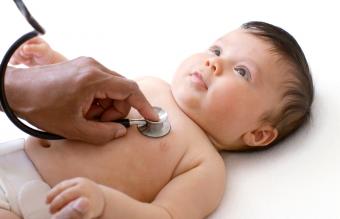
For new mothers, especially breastfeeding ones, infant thrush is an area of frequent concern. Thrush is a yeast infection of the mouth, and can occur in babies, as well as in toddlers. Thrush is most common in infants, and more common in breastfed infants than bottle-fed infants.
What Is Thrush?
Toddler and infant thrush is a yeast infection that is found in the mouth and perhaps also on the lips. Because yeast thrives in warm, moist places, the mouth is a perfect candidate. Infants can get thrush from anywhere (pinpointing the cause is usually impossible); however, bacteria traveling back and forth between an infant's mout and mother's nipples, is a prime candidate.
Thrush is usually diagnosed simply by looking at the mouth of a baby. White flecks or spots that cannot be wiped away are the characteristic sign of thrush. Most doctors will not bother taking a culture when they see this symptom because the one likely candidate is oral thrush.
Thrush can spread, causing a diaper rash of serious proportions. A diaper rash that is related to a yeast infection cannot be cured with diaper rash cream, so if your baby or toddler has a rash that is not helped by salves, your child may have a yeast diaper rash. If your child has or has just had oral thrush, a diaper rash often follows the oral thrush.
Infant thrush is more likely to come on following a course of antibiotics, which is just another reason to avoid excessive antibiotic use. Depending on the severity of the infection, you may be able to treat the infection without using prescription medications.
Treating Thrush
Two prescription medications are used to treat the oral yeast infection in infants and toddlers. Even newborn babies can be prescribed these medicines, albeit at lower doses than for older babies and children.
Nystatin is the most common drug used to treat thrush, with Diflucan also being prescribed by some doctors. Nystatin is generally cheaper than Diflucan, and there is no conclusive evidence in regards to one medicine being more effective than the other. It is the case, as with most medicines, that a certain medicine can work for one person, but not for the next. In general, Nystatin will be prescribed, and if symptoms do not improve, Diflucan may be ordered instead. Both of these medications are used topically to treat the yeast where it is growing, which can be a difficult task depending on the temperament and age of your child.
There are also homeopathic remedies for treating thrush, which have the ability to work very well, especially when the infection is still a rather minor one. Topically, gentian violet is a natural product that can be applied to the thrush infection in order to combat the yeast. In addition, it is important to keep surfaces as clean and dry as possible. Don't let your child suck on a bottle that is already empty, and don't use a pacifier unless your child really needs it, as the moisture stimulates yeast growth.
If you don't normally do it, sterilize bottles, nipples, pacifiers, teething rings, etc. after each use. If a case of thrush is cured and then comes back again quickly, you may want to throw out your nipples and pacifiers and buy new ones. If you breastfeed, wash and dry your nipples several times a day, especially after a feeding, and wear disposable pads inside your bra, changing them any time they become wet.
Additional Advice
While it is possible to cure some cases of infant thrush yourself, a yeast infection that does not go away, or that comes back regularly, is one that should be checked out by a doctor. Infant thrush can be a sign of a larger, systemic, problem in babies and toddlers, making it important to get checked out by a doctor if it's a particularly stubborn case.
In most occurrences though, infant thrush is a simple affliction with relatively painless symptoms. In most cases, infants and toddlers will recover fairly easily from a bout of thrush, oftentimes acting as though there's nothing amiss at all.







